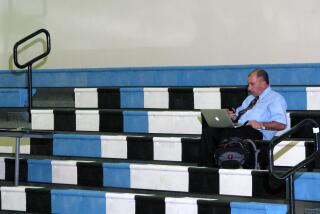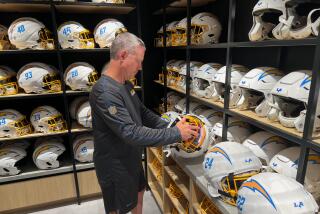Doctor Provides a Shield for High School Athletes
It’s a Friday afternoon, and this city’s high school football MVP is making another big play.
This time it’s a tackle, of a kid named Salvador Martinez, two hands on his shoulder pads that force him to remain on the tiny Crenshaw High bench.
While Martinez is down, Dr. Clarence Shields tenderly examines his stinging knee, calmly explains that it’s only a bruise, applies a bag of ice.
Without a program founded by Shields, the injury is treated somewhat different.
It is not treated at all.
Before Shields, Martinez keeps playing, risking further damage. He limps home and tries to heal it the way an old wife would, maybe applying some balm, maybe soaking it in a hot bath of Epsom salts.
The next day, he limps into a local emergency room where he is surrounded by several other inner-city football players doing the same thing.
After waiting all morning for X-rays, he is seen by an emergency room physician who may not be well-versed in sports medicine.
At best, the player limps out with the bag of ice and simple advice that he should have been given 24 hours earlier.
At worst, the doctor misses a torn ligament that will make itself painfully evident a week later.
“Before,” Martinez said, “you played until it hurt, then you kept playing until you couldn’t stand it anymore.”
And everybody played out of position. Coaches were trainers. Mothers were doctors. Children ignored their pain like men.
Then came Shields, whose Team HEAL project has provided a sliver of hope during a football season clouded by death.
The program, jointly sponsored by the Los Angeles Orthopaedic Hospital Foundation and the Kerlan-Jobe Clinic, gives two high schools something missing from every other in the Los Angeles Unified School District.
Two certified, full-time, fully paid, on-site trainers who work with every sport.
Completely monitored physical exams of every athlete before football and basketball season.
A doctor at every football game. A doctor available for any serious injury in any sport.
While only Crenshaw and Dorsey are involved so far--”They are the two schools closest to my office,” said Shields, who is not paid--he hopes to expand it when he finds more funding.
If this program was at Reseda High this year, who knows whether 18-year-old Eric Hoggatt would have died shortly after his complaints of numbness during the game were not thoroughly checked.
“I’ve always said, it’s very dangerous not to have more medical help on the sidelines,” said Robert Garrett, Crenshaw football coach. “People need to understand this.”
Until then, every city football game--including the current playoffs, which no longer involve Crenshaw or Dorsey--will begin with this question from the referee.
It involves the only assistance the players are guaranteed.
“Where’s the paramedic? Rules say we can’t start the game without a paramedic.”
At a recent Crenshaw-Dorsey game, that question was posed to the Crenshaw sideline when Shields gently interrupted.
“It’s OK. I’m a doctor,” he said.
“You’re a what?” said the referee.
Shields, small for someone with an impact so large, later shrugged.
“No doctors will come down here,” he said. “Nobody cares about these kids, medically. Sometimes you wonder.”
This Los Angeles native and longtime team doctor for the Rams was wondering the same thing two years ago when his team left town.
Having treated many neglected inner-city athletes for free during his Rams’ tenure, Shields wondered what would happen with a little prevention.
“I saw so many kids whose chances at college scholarships and maybe even more were cut short because of injuries that could have been treated. . . . I wondered why these kids shouldn’t be given a better chance,” he said.
One of those kids was a local running back who required major reconstructive knee surgery that could not have been properly treated in an emergency room.
Shields fixed him with about $20,000 worth of free work, and the kid won a college scholarship worth far more than that.
One day after his senior season, the player visited Shields’ office. “I wanted to give you something,” the player said.
It was a thank-you card. Shields framed it, and set about forming Team HEAL, an acronym for Helping Enrich Athletes Lives.
Today the results can be witnessed in the varied duties of his two trainers, who are sponsored by HealthSouth physical therapy and rehabilitation centers.
Crenshaw’s Warren Wood, a Brigham Young graduate who was far from his comfort zone in the inner city, has become the school safety net.
When Wood first arrived, the kids were so unfamiliar with trainers that when he treated them with ice, they ate it.
Dr. Clarence Shields, MVP for a second consecutive season, says he hopes this is only the beginning. For the children’s sake.
More to Read
Get our high school sports newsletter
Prep Rally is devoted to the SoCal high school sports experience, bringing you scores, stories and a behind-the-scenes look at what makes prep sports so popular.
You may occasionally receive promotional content from the Los Angeles Times.







